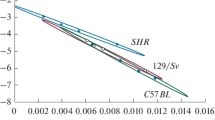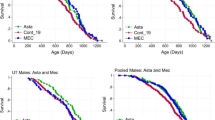Abstract
It has been speculated that ageing results from accumulation ofdamage to macromolecules, particularly DNA, owing to the actionof oxidising free radicals. This possibility would predict thatadministration of anti-oxidants might prolong lifespan, butprevious data on this prediction are conflicting. Three groups ofmice were exposed throughout life, from the time of conceptionuntil death, to 20, 40 and 400 mg/Kg of vitamin E in the diet. Noeffect on lifespan was observed and the median lifespans in thethree groups were 804, 830 and 801 days, respectively. The designof the study also enabled an effect of parental age on lifespanof female progeny to be sought, but no effect was detected.
Similar content being viewed by others
References
Berg BN (1959) Study of vitamin E supplements in relation to muscular dystrophy and other diseases in aging rats. J Gerontol 14: 174–180
Blackett AD andHall DA (1981) The effects of vitamin E on mouse fitness and survival. Gerontology 27: 133–139
Cortopassi GA andArnheim N (1990) Detection of specific mitochrondrial DNA deletion in tissues of older humans. Nucleic Acids Res 18: 6927–6933
Dempsey JL,Odagiri Y andMorley AA (1993) In vivo mutations at the H-2 locus in mouse lymphocytes. Mutation Res 285: 45–51
Enesco HE andVerdone-Smith C (1980) Alpha-tocopherol increases life span in rotifer Philodina. Exp Gerontol 15: 335–338
Gavrilov LA,Gavrilov NS,Kroutko VN,Evdokushkina GN,Semyonova VG,Gavriolova AL,Lapshin EV,Evdokushkina NN andKushnareva YE (1997) Mutation load and human longevity. Mutation Res 377: 61–62
Hattori K,Tanaka M,Sugiyama S,Obayashi T,Ito T,Satake T,Hanaki Y,Asai J,Nagano M andOzawa T (1991) Age-dependent increase in deleted mitochondrial DNA in the human heart: possible contributory factor to presbycardia. Am Heart J 121: 1735–1742
Heidrick ML,Hendricks LC andCook DE (1984) Effect of dietary 2-mercaptoethanol on the life span, immune system, tumor incidence and lipid peroxidation damage in spleen lymphocytes of aging BC3F1 mice. Mech Ageing Dev 27: 341–358
Jensen RH,Bigbee WL andLanglois RG (1988) In vivo somatic mutations in the glycophorin A locus of human erythroid cells In: Moore MM,DeMarini DM andTindall KR (eds) Banbury Report 28: Mammalian Cell Mutagenesis, pp 149–159. Cold Spring Harbor Laboratory, Cold Spring Harbor, New York
Kahn M andEnesco HE (1981) Effect of α-tocopherol on the life span of Urbatrix aceti. Age 4: 109–115
Kohn RR (1971) Effect of anti-oxidants in lifespan of C57H mice. J Gerontol 28: 415–424
Lansing AI (1947) A transmissible, cumulative, and reversible factor in aging. J Gerontol 2: 228–239
Ledvina M andHodanova M (1980) The effect of simultaneous administration of tocopherol and sunflower oil on the life-span of female mice. Exp Gerontol 15: 67–71
Linnane AW,Baumer A,Maxwell RJ,Preston H,Zhang CF andMarzuki S (1990) Mitochondrial gene mutation: the ageing process and degenerative diseases. Biochem Int 22: 1067–1076
Lipman RD,Bronson RT,Wu D,Smith DE,Prior R,Cao G,Han SN,Martin KR,Meydani SN andMeydani M (1998) Disease incidence and longevity are unaltered by dietary antioxidant supplementation initiated during middle age in C57BL/6 mice. Mech Ageing Dev 103: 269–284
McCarron MA,Kutlaca A andMorley AA (1989) The HLA mutation assay: improved technique and normal results. Mutation Res 225: 189–193
Miquel J,Binnard R andHoward WH (1973) Effect of dl-α-tocopherol on the life span of Drosophila melanogaster. Gerontologist 13: 37
Moore SR,Hill KA,Heinmoller PW,Halangoda A,Kunishige M,Buettner VL,Graham KS andSommer SS (1999) Spontaneous mutation frequency and pattern in Big Blue_ mice fed a vitamin E-supplemented diet. Environ Mol Mutagen 34: 195–200
Morley AA,Cox S andHolliday R (1982) Human lymphocytes resistant to 6-thioguanine increase with age. Mech Ageing Dev 19: 21–26
Morley AA,Grist SJ,Turner DR,Kutlaca A andBennett G (1990) The molecular nature of in vivo mutations in human cells at the autosomal HLA-A locus. Cancer Res 50: 4584–4587
Munscher D,Muller-Hocker J andKadenbach B (1993) Human aging is associated with various point mutations in tRNA genes of mitochondrial DNA. Biol Chem Hoppe-Seyler 374: 1099–1104
Odagiri Y,Uchida H,Hosokawa M,Takemoto K,Morley AA andTakeda T (1998) Accelerated accumulation of somatic mutations with age in lymphocytes of the senescence-accelerated mouse (SAM). Nature Genet 19: 117–118
Orr WC andSohal RS (1994) Extension of life-span by overexpression of superoxide dismutase and catalase in Drosophilia melanogaster. Science 263: 1128–1130
Porta EA,Joun NS andNitta RT (1980) Effects of the type of dietary fat at two levels of vitamin E in Wistar male rats during development and aging. I. Life span, serum biochemical parameters and pathological changes. Mech Ageing Dev 13: 1–39
Poulin JE,Cover C,Gustafson MR andKay MMB (1996) Vitamin E prevents oxidative modification of brain and lymphocyte band 3 proteins during aging. Proc Natl Acad Sci USA 93: 5600–5603
Reddy K,Fletcher B,Tappel A andTappel AL (1973) Measurement and spectral characteristics of fluorescent pigments in tissues of rats as a function of dietary polyunsaturated fats and vitamin E. J Nutr 103: 908–915
Tappel AL,Fletcher B andDeamer D (1973) Effects of antioxidants and nutrients on lipid peroxidation fluorescent products and aging parameters in the mouse. J Gerontol 28: 415–424
Thomas J andNyberg D (1988) Vitamin E supplementation and intense selection increase clonal life span in Paramecium tetraurelia. Exp Gerontol 23: 501–512
Trainor KJ,Wigmore DJ,Chrysostomou A,Dempsey J,Seshadri R andMorley AA (1984) Mutation frequency in human lymphocytes increases with age. Mech Ageing Dev 27: 83–86
Turner DR,Dreimanis M,Holt D,Firgaira FA andMorley AA (2001) Mitotic recombination is an important mutational event following oxidative damage. Cancer Research (submitted)
van Leeuwen F,van der Beek E,Seger M,Burbach P andIvell R (1989) Age-related development of a heterozygous phenotype in solitary neurons of the homozygous Brattleboro rat. Proc Natl Acad Sci USA 8: 6417–6420
Zhang C,Linnane AW andNagley P (1993) Occurrence of a particular base substitution (3243 A to G) in mitochondrial DNA of tissues of ageing humans. Biochem Biophys Res Commun 195: 1104–1110
Author information
Authors and Affiliations
Rights and permissions
About this article
Cite this article
Morley, A.A., Trainor, K.J. Lack of an effect of vitamin E on lifespan of mice. Biogerontology 2, 109–112 (2001). https://doi.org/10.1023/A:1011589218219
Issue Date:
DOI: https://doi.org/10.1023/A:1011589218219




